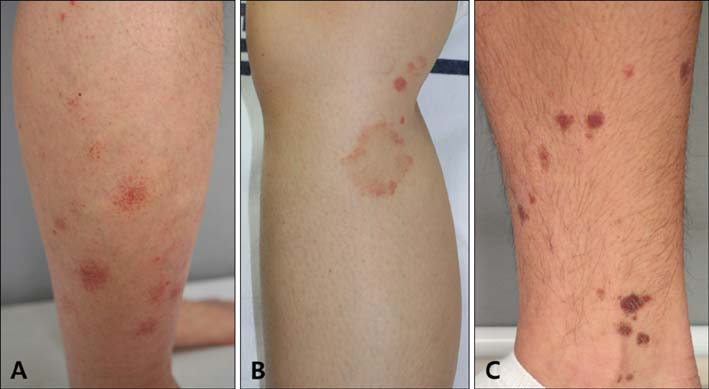Ann Dermatol.
2015 Aug;27(4):404-410. 10.5021/ad.2015.27.4.404.
Characteristics and Clinical Manifestations of Pigmented Purpuric Dermatosis
- Affiliations
-
- 1Department of Dermatology, Korea University College of Medicine, Seoul, Korea. grace79@korea.ac.kr
- KMID: 2171497
- DOI: http://doi.org/10.5021/ad.2015.27.4.404
Abstract
- BACKGROUND
Pigmented purpuric dermatoses (PPD) are a spectrum of disorders characterized by a distinct purpuric rash. Although PPD can be easily diagnosed, the disease entity remains an enigma and a therapeutic challenge.
OBJECTIVE
The purpose of this study was to investigate the characteristics and clinical manifestations of PPD and to elucidate the relationship between assumed etiologic factors and the clinical manifestations of PPD and treatment responses.
METHODS
Retrograde analyses were performed to identify appropriate PPD patients who visited Korea University Medical Center Anam Hospital from 2002 to 2012.
RESULTS
Information on 113 patients with PPD was analyzed, and 38 subjects with skin biopsy were included for this study. Schamberg's disease was the most frequent clinical type (60.5%). Concomitant diseases included hypertension (15.8%), diabetes (10.5%), and others. Associated medication histories included statins (13.2%), beta blockers (10.5%), and others. Possibly associated etiologic factors were recent upper respiratory infection (5.3%), high orthostatic pressure due to prolonged standing (2.6%), and strenuous exercise (2.6%). A total of 36 patients (94.7%) were treated with one or more treatment methods, including oral antihistamines, pentoxifylline, topical steroids, and/or phototherapy. There was no significant difference in disease progress according to underlying diseases, medications, or association factors (p>0.05).
CONCLUSION
Our overall results were grossly consistent with the existing literature, excluding several findings. Although a possible relationship between PPD and cardiovascular disease or cardiovascular medication was proposed at the beginning of the study, no statistically significant correlations were found according to the specific clinical types and treatment responses (p>0.05).
MeSH Terms
Figure
Cited by 1 articles
-
Dermoscopic Finding in Pigmented Purpuric Lichenoid Dermatosis of Gougerot-Blum: A Useful Tool for Clinical Diagnosis
Min-Young Park, Woo-Haing Shim, Jeong-Min Kim, Gun-Wook Kim, Hoon-Soo Kim, Hyun-Chang Ko, Moon-Bum Kim, Byung-Soo Kim
Ann Dermatol. 2018;30(2):245-247. doi: 10.5021/ad.2018.30.2.245.
Reference
-
1. Magro CM, Schaefer JT, Crowson AN, Li J, Morrison C. Pigmented purpuric dermatosis: classification by phenotypic and molecular profiles. Am J Clin Pathol. 2007; 128:218–229.2. Sardana K, Sarkar R, Sehgal VN. Pigmented purpuric dermatoses: an overview. Int J Dermatol. 2004; 43:482–488.
Article3. Cho JH, Lee JD, Kang H, Cho SH. The clinical manifestations and etiologic factors of patients with pigmented purpuric dermatoses. Korean J Dermatol. 2005; 43:45–52.4. Yung A, Goulden V. Pigmented purpuric dermatosis (capillaritis) induced by bezafibrate. J Am Acad Dermatol. 2005; 53:168–169.
Article5. Smoller BR, Kamel OW. Pigmented purpuric eruptions: immunopathologic studies supportive of a common immunophenotype. J Cutan Pathol. 1991; 18:423–427.
Article6. Ratnam KV, Su WP, Peters MS. Purpura simplex (inflammatory purpura without vasculitis): a clinicopathologic study of 174 cases. J Am Acad Dermatol. 1991; 25:642–647.
Article7. Fishman HC. Pigmented purpuric lichenoid dermatitis of Gougerot-Blum. Cutis. 1982; 29:260–261. 2648. Newton RC, Raimer SS. Pigmented purpuric eruptions. Dermatol Clin. 1985; 3:165–169.
Article9. Tristani-Firouzi P, Meadows KP, Vanderhooft S. Pigmented purpuric eruptions of childhood: a series of cases and review of literature. Pediatr Dermatol. 2001; 18:299–304.
Article10. Saito R, Matsuoka Y. Granulomatous pigmented purpuric dermatosis. J Dermatol. 1996; 23:551–555.
Article11. Devere TS, Patel AB. Pigmented purpuric dermatoses. In : Goldsmith LA, Katz SI, Gilchrest BA, Paller AS, Leffell DJ, Wolff K, editors. Fitzpatrick's dermatology in general medicine. 7th ed. New York: McGraw-Hill;2008. p. 2049–2054.12. Taketuchi Y, Chinen T, Ichikawa Y, Ito M. Two cases of unilateral pigmented purpuric dermatosis. J Dermatol. 2001; 28:493–498.
Article13. Rudolph RI. Lichen aureus. J Am Acad Dermatol. 1983; 8:722–724.
Article14. Hercogova J. Persistent pigmented purpuric dermatoses: who are you? J Eur Acad Dermatol Venereol. 2001; 15:15.
Article15. Filo V, Galbavý S, Filová A, Borecká D, Novotná V. Unilateral progressive pigmented capillaropathy (Schamberg's disease?) of the arm. Br J Dermatol. 2001; 144:190–191.
Article16. Kwon SJ, Lee CW. Figurate purpuric eruptions on the trunk: acetaminophen-induced rashes. J Dermatol. 1998; 25:756–758.
Article17. Adams BB, Gadenne AS. Glipizide-induced pigmented purpuric dermatosis. J Am Acad Dermatol. 1999; 41:827–829.
Article18. Wong WK, Ratnam KV. A report of two cases of pigmented purpuric dermatoses treated with PUVA therapy. Acta Derm Venereol. 1991; 71:68–70.19. Nishioka K, Katayama I, Masuzawa M, Yokozeki H, Nishiyama S. Drug-induced chronic pigmented purpura. J Dermatol. 1989; 16:220–222.
Article20. Pietrzak A, Brzozowska A, Lotti T, Mosiewicz J, WysokiXMLLink_XYZski A, Mieczkowska J, et al. Future diagnosis, today's treatment -cardiomyopathy in the course of psoriasis: a case report. Dermatol Ther. 2013; 26:489–492.
Article21. Kocaturk E, Kavala M, Zindanci I, Zemheri E, Sarigul S, Sudogan S. Narrowband UVB treatment of pigmented purpuric lichenoid dermatitis (Gougerot-Blum). Photodermatol Photoimmunol Photomed. 2009; 25:55–56.
Article22. Mun JH, Jwa SW, Song M, Kim HS, Ko HC, Kim BS, et al. Extensive pigmented purpuric dermatosis successfully treated with pentoxifylline. Ann Dermatol. 2012; 24:363–365.
Article
- Full Text Links
- Actions
-
Cited
- CITED
-
- Close
- Share
- Similar articles
-
- A Case of Granulomatous Pigmented Purpuric Dermatosis
- A Case of Granulomatous Pigmented Purpuric Dermatosis
- Pigmented Purpuric Dermatosis Associated with the Surgical Site
- A Study of Granulomatous Pigmented Purpuric Dermatosis
- Two Cases of Pigmented Purpuric Dermatosis after ChAdOx1 COVID-19 Vaccination




